Monday, 14 May 2012. Posted in Features
CIMMYT E-News, vol 5 no. 10, October 2008
A team in Mauritius working on the wheat-growing project As the price of wheat goes up, countries such as the Republic of Mauritius are feeling the pinch. A former British colony off the coast of Madagascar, it imports most of its wheat from France and Australia. But with help from CIMMYT, the island has started trials to grow its own wheat—and results to date look promising.
The CIMMYT germplasm bank freely distributes maize and wheat seed to hundreds of partners worldwide each year. In January 2008, Tom Payne, Head of CIMMYT’s wheat germplasm bank (seed bank), received a request for wheat seed from Mala Gungadurdoss, Head of the Mauritanian Agronomy Department at the Ministry of Agro-industry. “The rising price of imported wheat coupled with a scarcity on the international market (made us) revisit our food and agricultural policy,” explains Gungadurdoss, who is also Principle Research Scientist of the Agricultural Research and Extension Unit. “Our food security is at stake, since Mauritius imports most of its staples.”
Payne sent a “yield trial” of 49 elite spring wheat lines that he thought might flourish in the climactic conditions and disease spectrum of the island. “In a way, it’s kind of an exploratory experiment,” he says. “I don’t really know their environment and they don’t really know wheat, so I sent them something to see if it fit their conditions.”
Payne’s selection was apparently successful. “I am really satisfied with the yields of above 5 tons per hectare for 13 of the lines,” says Gungadurdoss. “I consider these yields to be very good when I compare them to yields of 1.5-3 tons per hectare obtained in the trials of 1985-1993,” referring to the last period during which the country grew wheat trials. Gungadurdoss admits that recent conditions were conducive to achieving good yields; but the highest yields for this year’s trial ranging from 5.8 to 6.4 tons per hectare are not only vastly superior to the results of previous trials; they are more than twice wheat’s global average of 2.5 tons per hectare.
Wheat’s roots in Mauritius
The Dutch introduced wheat to Mauritius in 1598 and it was grown on a commercial scale in the 1820s. But only about 1,700 hectares were under cultivation by the end of the 1930s, when the island began focusing on growing the more profitable sugarcane and importing wheat, which was far less expensive to buy, according to Gungadurdoss. “Up until three years ago, wheat was very cheap,” says Payne. “It was overproduced in Europe, North America, and Australia. This is one of the reasons the price of wheat and other grains stayed low for long time.”
Most people who live on Mauritius are of Indian origin and eat food staples such as chappatis, pharatas, puris, and bread made from wheat and wheat flour, says Gungadurdoss. In 2007 the island imported around 140,000 tons of unmilled wheat and 9,000 tons of flour. Over the last 5 years the country imported an average of 137,000 tons of unmilled wheat and 9,500 tons of wheat flour costing USD 28 million. The per capita consumption of wheat flour averaged 74 kilograms per year, and this is expected to increase in the future, according to Gungadurdoss.
Some of the early yields have been over 5 tons per hectare, which is more than twice wheat’s global average of 2.5 tons per hectare.Thanks to the wheat breeding lines sent by CIMMYT, agronomists on Mauritius can screen promising wheat lines for high grain yield, early maturity, resistance to major pests and diseases, and good baking characteristics; assess wheat’s economic feasibility under local conditions; identify the main constraints to production and devise corrective measures; and conserve their own elite germplasm (seeds and genetic material).
“Based on whatever results the agronomists from Mauritius send us, we can send them more lines from CIMMYT’s wheat germplasm bank and international nurseries,” says Payne. “These lines will have much broader genetic variation and will be even better suited for the island.”
Homegrown wheat could be within reach
For now, growing wheat in Mauritius is still in the early stages; sowing, weeding, harvesting, threshing and winnowing were done manually at Réduit Crop Research Station. One of the next steps will be to research the economic viability of growing and processing wheat using mechanization which will be tested on a much larger scale, possibly with interested farmers in 2009, according to Gungadurdoss.
“Once the economic feasibility is determined, we can decide on our future move: maybe large-scale production in line with cross border initiatives with Madagascar or Mozambique to substitute part of our imports can be considered.”
“I think Mauritius gets enough rainfall for wheat, and it’s on roughly the same latitude as countries or regions that get good yields, such as Uruguay, Zimbabwe, and northern Mexico, so high wheat yields should definitely be possible,” says Hans-Joachim Braun, Director of CIMMYT’s Global Wheat Program.
For more information: Tom Payne, Head, Wheat Germplasm Bank (t.payne@cgiar.org)
More stories on agriculture in Mauritius (both in French)
Mala Gungadurdoss (Areu) : «Du riz et du blé Made in Mauritius, c’est possible»
Le blé made in Mauritius bientôt à portée de bouche
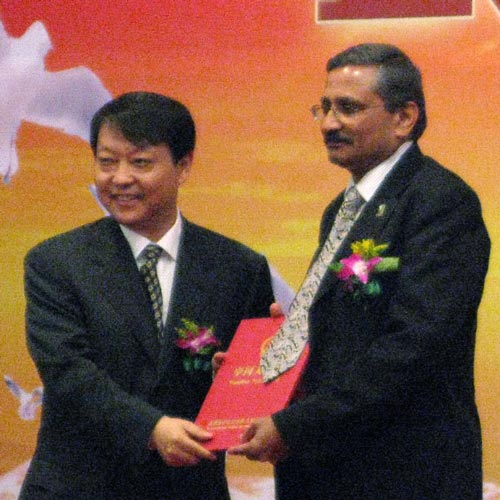 Ravi Singh, distinguished scientist and head of Bread Wheat Improvement and Rust Research, Global Wheat Program, received the 2012 China Tianshan Award for his contributions to the economic and social progress of the Xinjiang Uygur Autonomous Region of China. The highest award given to foreign experts by the Government of Xinjiang Province was presented by Huang Wei, Executive Vice- Governor of the Province, on 27 September 2012 during a ceremony at Urumqi attended by over 150 officials and guests.
Ravi Singh, distinguished scientist and head of Bread Wheat Improvement and Rust Research, Global Wheat Program, received the 2012 China Tianshan Award for his contributions to the economic and social progress of the Xinjiang Uygur Autonomous Region of China. The highest award given to foreign experts by the Government of Xinjiang Province was presented by Huang Wei, Executive Vice- Governor of the Province, on 27 September 2012 during a ceremony at Urumqi attended by over 150 officials and guests.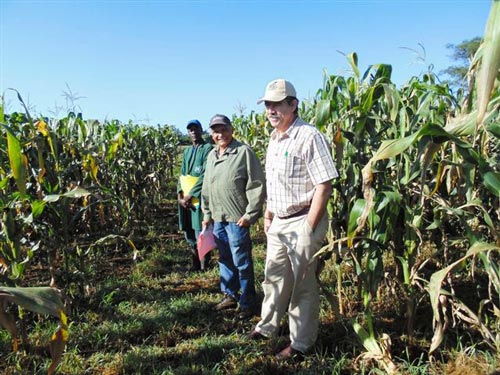 Strengthening and enhancing seed systems is critical to ensure that released varieties reach the ultimate beneficiary — the farmer, and that farmers, especially smallholders, are able to access improved maize seed varieties from seed companies who are often key players in the maize value chain. This is why scientists working on seed systems at CIMMYT met with seed companies at the Uganda Seed Trade Association (USTA) meeting during 19-20 September 2012 in Kampala, Uganda. CIMMYT was represented by seed system specialists John MacRobert and Mosisa Worku, whose objective was to create awareness on new drought tolerant (DT) maize varieties and roadmaps for their seed production. The meeting was attended by 12 participants representing 9 seed companies, along with representatives from USTA.
Strengthening and enhancing seed systems is critical to ensure that released varieties reach the ultimate beneficiary — the farmer, and that farmers, especially smallholders, are able to access improved maize seed varieties from seed companies who are often key players in the maize value chain. This is why scientists working on seed systems at CIMMYT met with seed companies at the Uganda Seed Trade Association (USTA) meeting during 19-20 September 2012 in Kampala, Uganda. CIMMYT was represented by seed system specialists John MacRobert and Mosisa Worku, whose objective was to create awareness on new drought tolerant (DT) maize varieties and roadmaps for their seed production. The meeting was attended by 12 participants representing 9 seed companies, along with representatives from USTA.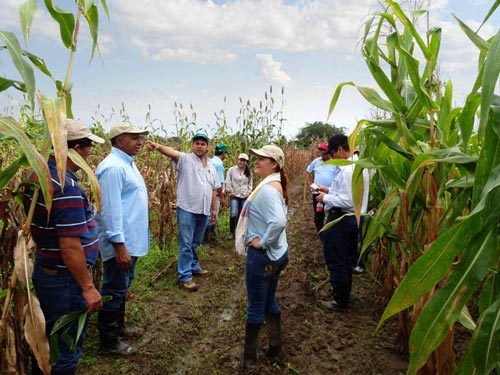 The
The 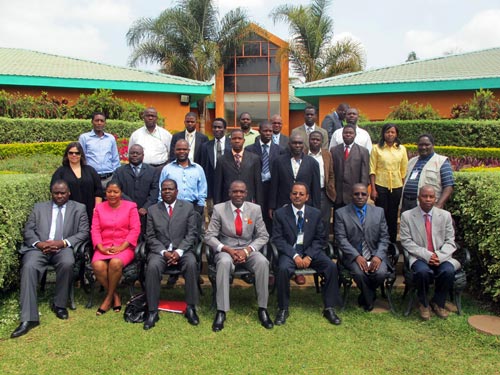
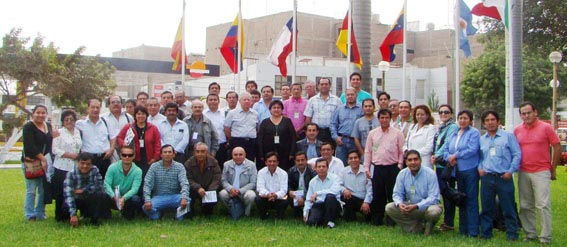
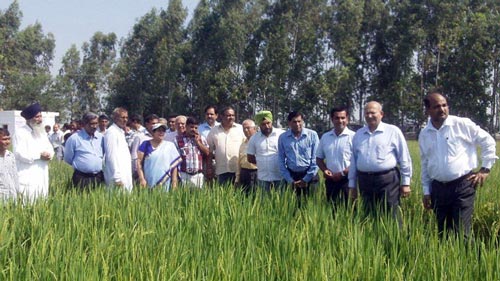 While cereal production in India has increased significantly since the mid-1960s as a result of the Green Revolution, securing the gains achieved is becoming more difficult in the context of soaring food and fuel prices, volatile markets, depleting water resources, soil degradation, and the effects of global climate change. To discuss strategies for improving efficiency and resilience of farming systems as a way to ensure sustainable food security, over 400 participants gathered for an in-field stakeholder meeting on ‘Empowering Farmers for Climate Smart Agricultural Practices in Haryana’ in Taraori, Karnal, India, on 28 September 2012. The event was organized by the CGIAR Research Program on Climate Change, Agriculture and Food Security (
While cereal production in India has increased significantly since the mid-1960s as a result of the Green Revolution, securing the gains achieved is becoming more difficult in the context of soaring food and fuel prices, volatile markets, depleting water resources, soil degradation, and the effects of global climate change. To discuss strategies for improving efficiency and resilience of farming systems as a way to ensure sustainable food security, over 400 participants gathered for an in-field stakeholder meeting on ‘Empowering Farmers for Climate Smart Agricultural Practices in Haryana’ in Taraori, Karnal, India, on 28 September 2012. The event was organized by the CGIAR Research Program on Climate Change, Agriculture and Food Security (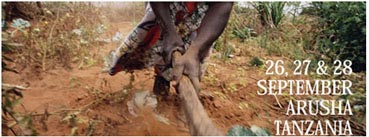 “We have arrived at the tipping point and are not taking Africa’s Green Revolution to scale,” said Kofi Annan during the opening session of the 2012 African Green Revolution Forum which took place in Arusha, Tanzania, from 26-28 September. The forum gathered 1,000 participants from ministries of agriculture, industry, and the international donor community. CIMMYT was represented by Wilfred Mwangi. Melinda Gates of the Bill & Melinda Gates Foundation (
“We have arrived at the tipping point and are not taking Africa’s Green Revolution to scale,” said Kofi Annan during the opening session of the 2012 African Green Revolution Forum which took place in Arusha, Tanzania, from 26-28 September. The forum gathered 1,000 participants from ministries of agriculture, industry, and the international donor community. CIMMYT was represented by Wilfred Mwangi. Melinda Gates of the Bill & Melinda Gates Foundation (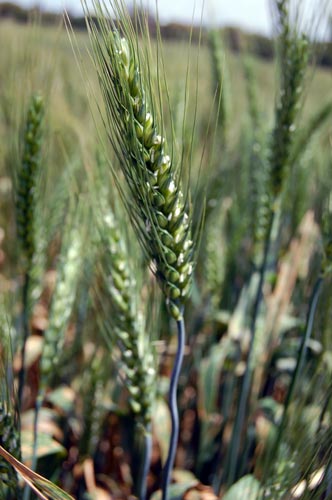 It was another exhausting, but productive day at the Wheat for Food Security in Africa conference at Addis Ababa, culminating in a wonderful evening of traditional dancing and the Injera cuisine so typical of Ethiopia. In case you missed any of our live tweeting during the day (#W4A), here is a brief roundup of the main events. It would be impossible to describe everything that happened in one short post, but this was a day likely to produce impacts in the months to come.
It was another exhausting, but productive day at the Wheat for Food Security in Africa conference at Addis Ababa, culminating in a wonderful evening of traditional dancing and the Injera cuisine so typical of Ethiopia. In case you missed any of our live tweeting during the day (#W4A), here is a brief roundup of the main events. It would be impossible to describe everything that happened in one short post, but this was a day likely to produce impacts in the months to come.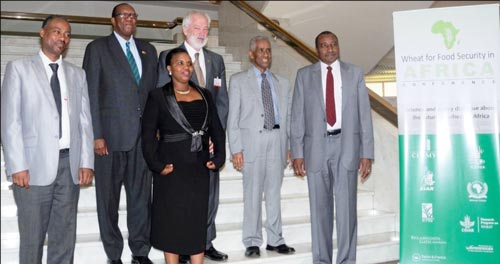
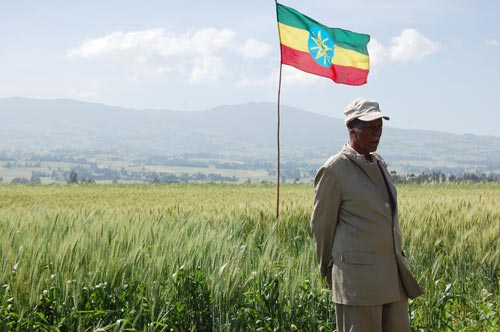 After two days in
After two days in